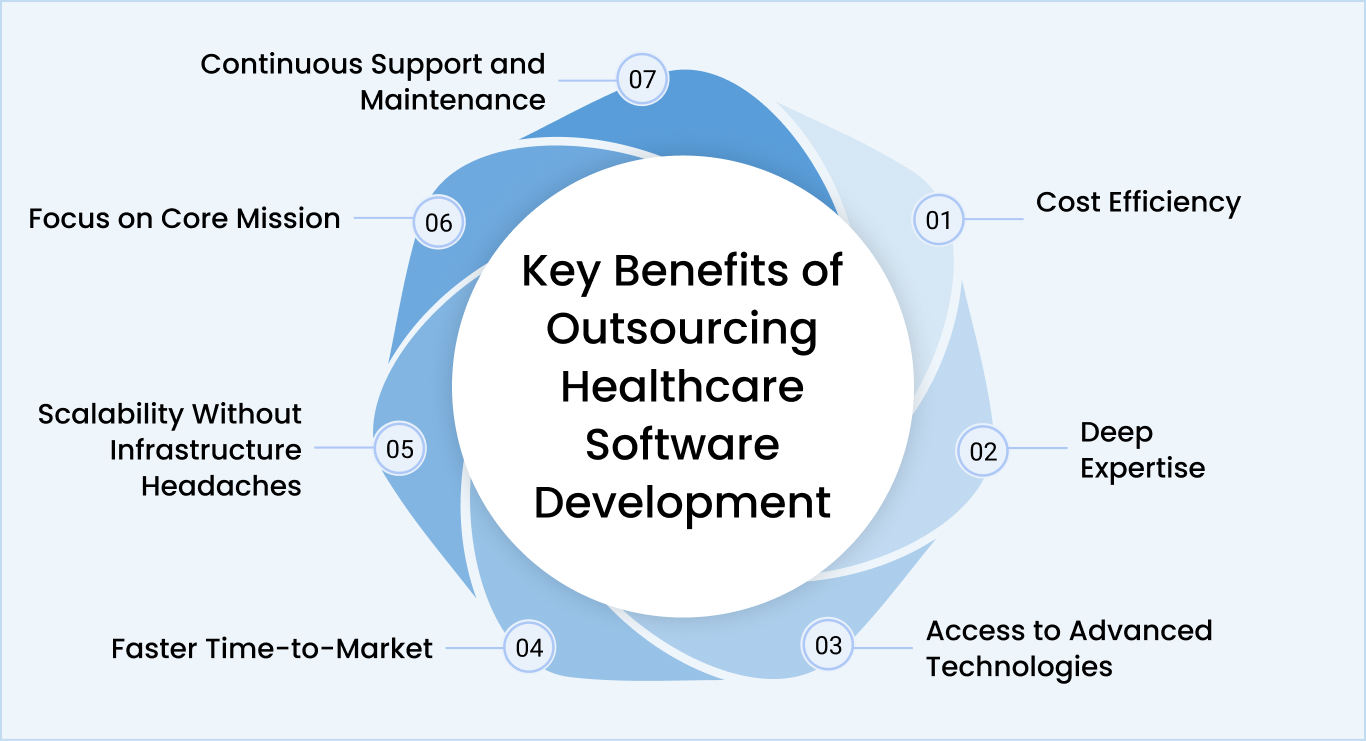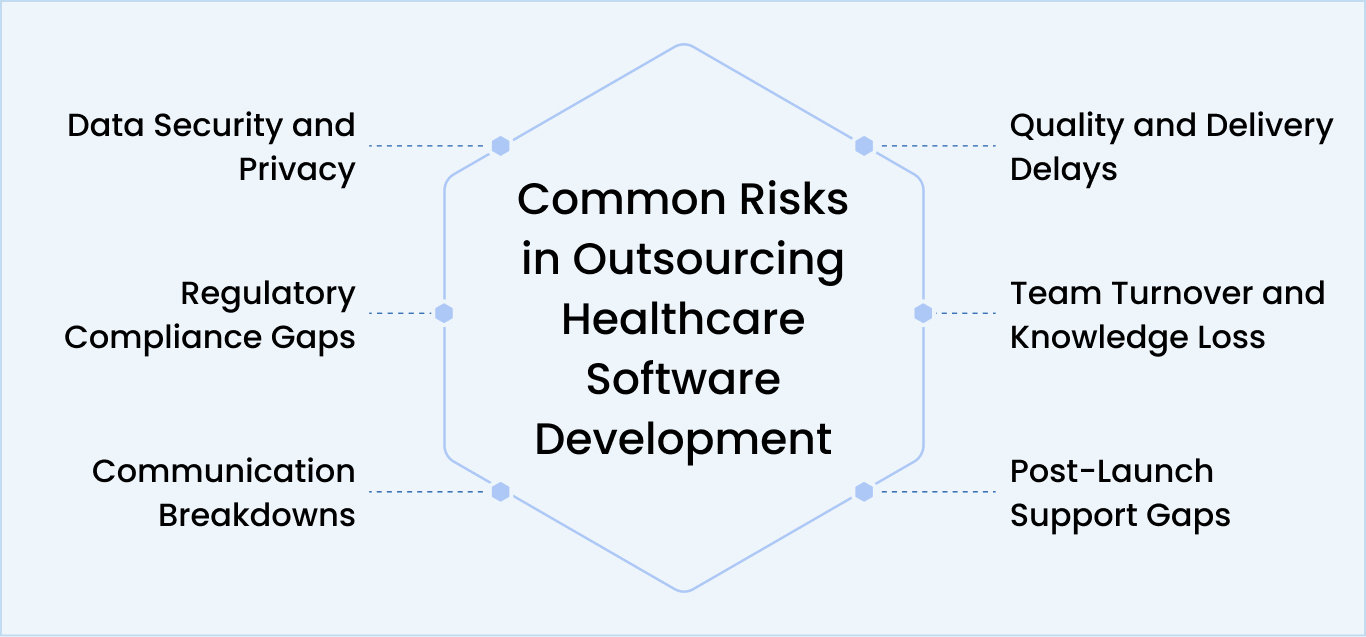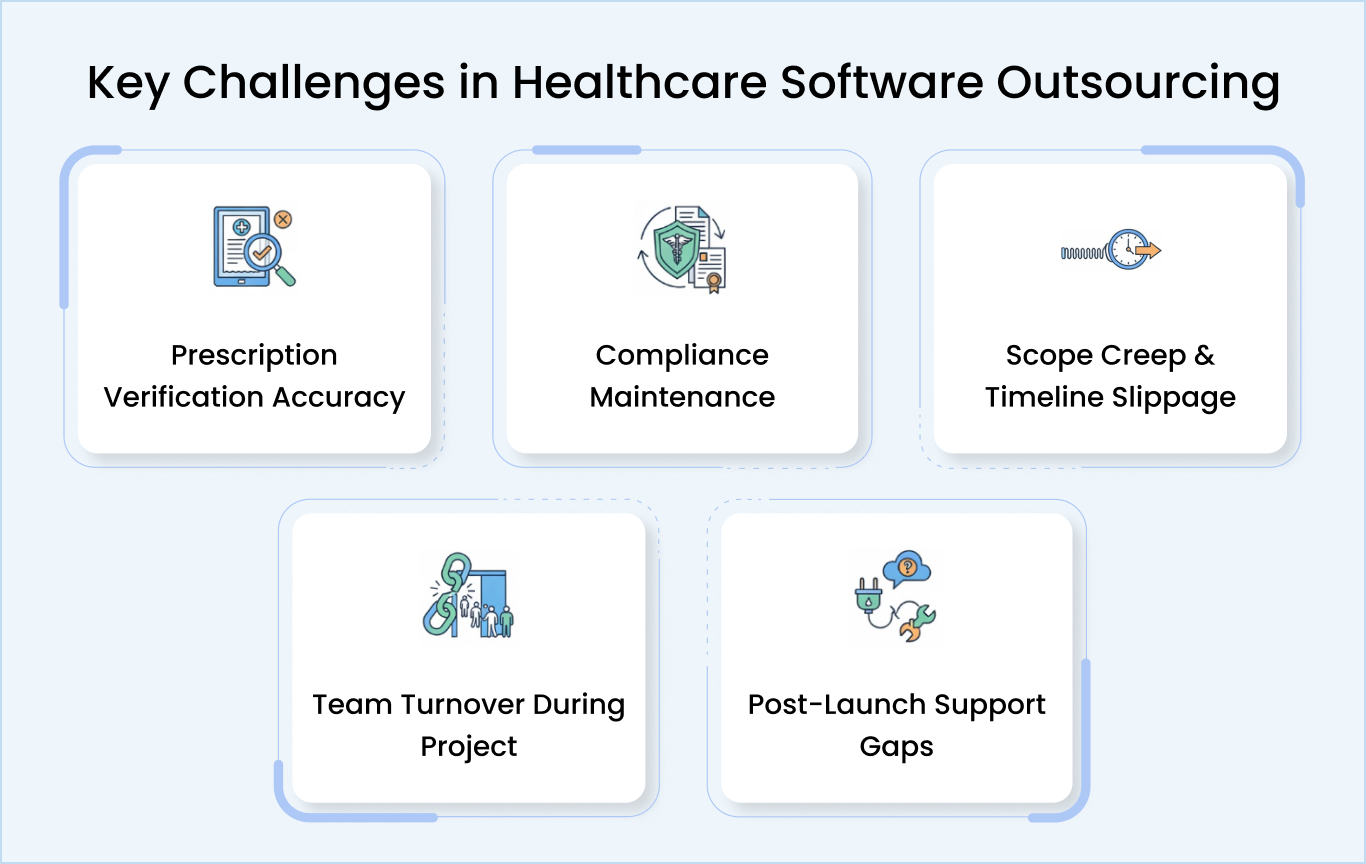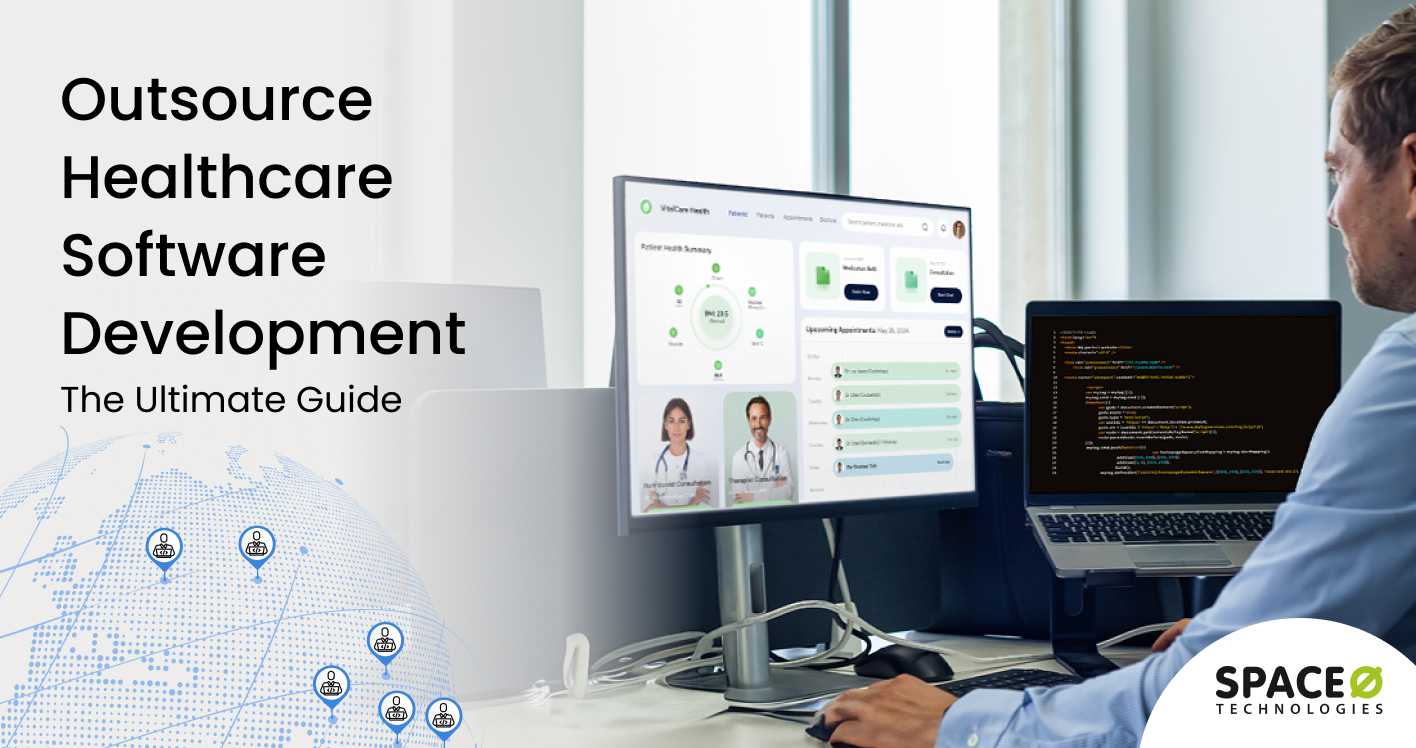Healthcare organizations everywhere are moving toward digital first systems, and many are realizing that they cannot do it alone. That is why outsourcing has become one of the most practical ways to build secure, compliant, and high quality healthcare software.
In fact, Future Market Insights reports that the global healthcare IT outsourcing market reached 60.6 billion dollars in 2025 and is on track to grow to 117.1 billion dollars by 2035. This surge makes one thing clear. Healthcare providers and healthtech companies increasingly prefer trusted technology partners to bring their digital ideas to life.
When you outsource healthcare software development to a healthcare software development company, you get access to specialized engineers, compliance experts, interoperability specialists, and cloud architects who already understand how complex healthcare systems can be.
In this guide, we will walk through the benefits, costs, challenges, processes, and best practices so you can decide whether outsourcing healthcare software development is the right step for your organization.
Table of Contents
What Is Healthcare Software Development Outsourcing?
Outsourcing healthcare software development refers to partnering with an external software development company to design, build, test, and maintain your healthcare software solution. Instead of relying only on your internal team, you work with a specialized software development partner that already has the technical skills, healthcare domain knowledge, and compliance experience needed to deliver high quality solutions.
In healthcare, outsourcing is especially common because digital systems often require deep expertise in areas like interoperability, data security, integration with EMRs, and compliance with HIPAA, GDPR, HL7, and FHIR.
Building this expertise in house can be costly and time consuming, so many organizations choose to work with experienced outsourcing partners who can handle both the technology and the regulatory requirements.
Strategic Benefits of Outsourcing Healthcare Software Development

Outsourcing healthcare software development offers more than just cost savings. It gives organizations strategic advantages that help them innovate faster and stay competitive. Here are the benefits of outsourcing your healthcare software development project:
Improves cost efficiency
In-house healthcare developers cost significantly more when you factor in salary, benefits, equipment, and training. Outsourcing reduces total development costs because you pay only for the work you need, not permanent overhead.
You avoid recruitment expenses, long-term salary commitments, and infrastructure costs. Plus, development continues 24/7 across time zones, compressing your timeline and accelerating ROI.
Provides specialized expertise and domain knowledge
Healthcare software development agencies have years of experience in developing healthcare platforms. This experience helps them understand HIPAA, HL7/FHIR standards, and clinical workflows from deep industry experience.
Outsourcing partners also have pre-built compliance frameworks (ISO 27001:2022, HIPAA infrastructure) ready to deploy. This expertise would take internal teams months or years to develop from scratch.
Offers access to advanced technologies
Developing modern healthcare software demands AI diagnostics, blockchain security, IoT wearable integration, and scalable cloud architecture. Building this technology infrastructure in-house is expensive and difficult. Outsourced teams bring proven implementations in these technologies, giving you cutting-edge capabilities without the hiring burden.
Reduces time-to-market
Hiring a team of software developers takes 2–3 months; and training takes another month. Outsourced teams launch MVPs in 3–4 months, pilot projects in 6–8 weeks, and complex EHR systems in 10–12 months. Speed translates directly to competitive advantage and market leadership.
Increases scalability without infrastructure headaches
Your team needs fluctuate: 3 developers today, 15 in six months, 8 after launch. Outsourcing scales seamlessly without office space, recruiting, or severance complications. Infrastructure grows in cloud environments, not physical real estate.
Gives teams more time to focus on core mission
Healthcare professionals should focus on patient care, not software maintenance. Outsourcing frees leadership to prioritize clinical outcomes, patient satisfaction, and strategic decisions instead of IT infrastructure management.
Enables continuous support and maintenance
Development doesn’t end at launch. Outsourcing partners provide 24/7 monitoring, security patches, OS updates, and feature enhancements. Proactive support prevents crises and ensures long-term reliability.
Understanding these benefits explains why outsourcing makes business sense. But the real question is: when should you actually outsource? Not every situation calls for it, and understanding the right scenarios prevents costly mistakes.
Get a Healthcare Development Team That Delivers Real Results
Join 1200+ clients who trust Space O Technologies to build high quality digital healthcare products faster and more efficiently.

When Should You Outsource Healthcare Software Development?
Not every healthcare software project requires outsourcing, and understanding when to outsource prevents costly mistakes. This framework helps you evaluate whether you should hire software developers from an outsourced agency or build an internal development team:
Scenarios where outsourcing makes perfect sense
Outsourcing is ideal when you need fast access to specialized healthcare developers, want to speed up development, or lack in-house expertise in compliance, integration, or interoperability.
- Talent Shortage: Finding healthcare software developers locally is nearly impossible. Outsourcing lets you tap global talent pools without recruiting or relocation costs. You get specialized expertise immediately instead of waiting months to hire.
- Urgent Timeline: In-house hiring takes 3+ months before development even starts. Outsourcing launches in weeks with established teams and proven processes. You compress timelines by months, hitting market windows your competitors miss.
- Specialized Skills: Specialized Skills: Blockchain, AI/ML, and advanced security require rare expertise that you can’t hire permanently. Custom healthcare software development companies maintain these capabilities across projects. You access cutting-edge technology without expensive full-time specialists.
- Compliance Urgency: Building HIPAA-compliant software from scratch risks costly mistakes and rework. Outsourced teams have compliance frameworks already built in. You launch compliant from day one, not months later after remediation.
- Legacy Modernization: Migrating decades-old systems to modern platforms while keeping operations running is complex. Custom healthcare software development companies have done this repeatedly. They modernize without disrupting patient care or business continuity.
- MVP Validation: Testing market demand before hiring a full team reduces risk. Outsourced partners understand how to build a minimum viable product for healthcare efficiently. You validate demand and refine before committing to a larger, permanent investment.
- Cost Constraints: Permanent developers cost a significant annual investment plus overhead. Custom healthcare software development companies operate on project-based pricing. You scale spending up or down based on actual project needs.
Scenarios requiring hybrid approaches
Some projects benefit from a mix of internal knowledge and external expertise. A hybrid model works well when you need to maintain some internal control while still leveraging outside talent for complex engineering, security, or compliance heavy tasks.
- Highly Sensitive IP: Your proprietary algorithms are too valuable to outsource completely. Keep critical IP development in-house where you maintain full control. Outsource non-core features, testing, and infrastructure work to accelerate delivery without exposing your competitive advantage.
- Full Control Needed: Your organization requires strict oversight of data handling and security practices. Work with custom healthcare software development companies offering on-premise deployment or hybrid models. You retain control while leveraging their expertise for specific components.
- Blended Teams: Many organizations use outsourcing for development and QA while retaining in-house architects, compliance officers, and security leads. This balances speed and cost savings with oversight and control. Your internal team guides strategy while outsourced teams execute.
Once you know when outsourcing makes sense for your project, the next factor to consider is cost. Let us look at what influences the cost of outsourcing healthcare software development.
Cost of Outsourcing Healthcare Software Development
The cost to outsource healthcare software development varies dramatically based on project scope, complexity, and features. Understanding cost structures prevents budget surprises and helps you make informed outsourcing decisions.
Understanding project complexity tiers
Healthcare software development costs depend on three primary tiers. Each tier is defined by scope, timeline, team size, and the complexity of features you’re building.
Basic MVP: $40,000–$80,000 (3–4 months)
This tier is ideal for validating concepts and market demand before a larger investment. You get single-platform deployment (iOS or Android only) with essential features like user registration, basic search, simple payments, and order tracking.
Examples include appointment booking apps and basic patient portals. A small team of 2–3 developers handles the entire project.
Mid-Level software: $80,000–$150,000 (5–7 months)
This is where most healthcare organizations land. You receive cross-platform development (both iOS and Android), real-time tracking, dashboards, and standard EHR or payment integrations.
Examples include medicine delivery apps, basic telemedicine platforms, and simple EHR systems. Your team expands to 4–6 developers plus dedicated QA engineers and designers. This represents the standard healthcare solution for growing organizations.
Enterprise-level software: $150,000–$300,000+ (8–12 months)
Complex healthcare ecosystems requiring complete integration with existing systems belong here. You get advanced features including AI recommendations, video consultations, subscription management, and analytics dashboards.
Examples include full hospital management systems, complex EHR platforms, and healthcare marketplaces
Healthcare software development cost based on development team’s location
You can outsource your healthcare software development project to developers all across the world. The location you choose for development significantly impacts the cost of healthcare software development, as developer salaries vary across the world.
| Region | Hourly Rate | Best Scenarios |
|---|---|---|
| North America | $80–$150/hour | Complex projects needing zero timezone coordination. On-site team presence required. Maximum oversight and control are needed. |
| Western Europe | $60–$150/hour | Organizations want balanced cost and quality. Cultural compatibility with US/EU clients. Time zone overlaps with the US East Coast. |
| Eastern Europe (Poland, Ukraine, Romania, Bulgaria) | $30–$70/hour | Organizations want balanced cost savings and quality. Cultural compatibility with the US/EU. Time zone overlap with Western Europe and the US East Coast. |
| India/Asia | $20–$40/hour | Budget-conscious projects where cost is the primary driver. High-volume, less complex work. The vendor ecosystem is mature and established. |
| Latin America | $30–$60/hour | US companies are prioritizing communication and collaboration over maximum cost savings. Better working hours overlap than offshore Asia. |
Outsourcing destination choice depends on your priorities. North America and Western Europe offer the same time zone support and maximum control, but at the highest cost. Eastern Europe delivers significant savings (50–60% reduction) while maintaining quality and cultural alignment.
India and Asia provide the lowest rates for organizations where cost efficiency is the primary driver. Latin America strikes a balance between affordability and collaboration convenience for US-based teams.
Now that you understand project costs across regions, it’s important to recognize that cheaper doesn’t always mean better value. Outsourcing introduces specific risks that can erode cost savings quickly. Understanding these risks upfront and knowing how to mitigate them prevents costly mistakes.
Get a Precise Cost Estimate for Your Healthcare Software Project
Share your requirements and get a detailed breakdown of timelines, team size, and cost from our experienced healthcare development experts.
Managing Risks in Healthcare Software Development Outsourcing

Outsourcing healthcare software development introduces specific risks that in-house development doesn’t have. Understanding these risks upfront and knowing how to mitigate them prevents costly mistakes and protects your organization.
Data security and privacy
Risk: Healthcare data is highly targeted. Breaches cost organizations millions and damage patient trust irreparably.
- Verify HIPAA compliance documentation and SOC 2 Type II certification
- Require ISO 27001:2022 certification before engagement
- Demand Business Associate Agreements in writing
- Ask about incident response procedures and breach history
- Request references from current healthcare clients about security practices
Mitigation Strategies:
Regulatory compliance gap
Risk: Non-compliance means rework, fines, and operational disruption. Building HIPAA-compliant software from scratch is risky for teams without healthcare experience.
- Choose partners with proven healthcare projects in your target geography
- Verify understanding of local regulations (HIPAA, GDPR, state laws)
- Require compliance officer involvement from project kickoff through launch
- Include compliance validation in contract Service Level Agreements
- Conduct a compliance audit before go-live
Mitigation Strategies:
Communication breakdowns
Risk: Misunderstood requirements result in wrong products, wasted time, and missed market windows. Timezone differences and language barriers compound this risk.
- Select partners with excellent English proficiency and healthcare domain knowledge
- Establish structured communication: daily standups, weekly demos, sprint reviews
- Use project management tools (Jira, Asana) for transparency
- Define requirements in extreme detail before development starts
- Maintain overlapping working hours with offshore teams
Mitigation Strategies:
Quality and delivery delays
Risk: Poor code quality creates expensive rework. Missed deadlines kill competitive advantage and investor confidence.
- Review portfolios of similar healthcare projects before engagement
- Start with a pilot project to gauge quality and fit
- Define clear SLAs with penalty clauses for missed deadlines
- Require regular code reviews and automated testing throughout development
- Maintain ongoing communication checkpoints with demo requirements
Mitigation Strategies:
Team turnover and knowledge loss
Risk: Key developers leaving mid-project stalls momentum and loses institutional knowledge. This creates cascading delays and quality issues.
- Require team redundancy so that at least 2 developers understand each component
- Demand comprehensive documentation and knowledge transfer processes
- Include SLA penalties for unexpected developer departures
- Ensure you own all code and documentation, preventing vendor lock-in
- Request detailed handover procedures if team changes occur
Mitigation Strategies:
Post-launch support gaps
Risk: Partners disappearing after launch leave critical bugs unfixed and systems unreliable. This damages patient trust and operational continuity.
- Define post-launch SLAs clearly in contracts (1-hour response for critical bugs)
- Retain maintenance budget (15–20% of development cost annually)
- Assign a dedicated support contact before launch
- Establish escalation procedures for urgent issues
- Schedule regular check-ins during the first 3–6 months post-launch
Mitigation Strategies:
Recognizing these risks is the first step. The real protection comes from choosing partners with proven processes to manage them. The vendor evaluation framework in the next section shows you exactly what separates qualified partners from those who create problems.
How to Choose the Right Healthcare Software Development Partner
Choosing the right development partner is one of the most important decisions you will make during your outsourcing journey. The right company can accelerate your roadmap, simplify compliance, improve product quality, and reduce long term risks.
Factors to consider while choosing a healthcare software development vendor
Before contacting vendors, get clear on your own requirements. This clarity improves decision-making and prevents misaligned expectations with potential partners.
- Define project scope: MVP vs. enterprise system?
- Set a realistic budget: Include post-launch support and hidden costs
- Establish timeline: When does the launch need to happen?
- Identify non-negotiables: Compliance requirements, technology preferences, team structure needs
- Assess risk tolerance: How much oversight do you need?
- Research broadly: Create a shortlist of 5-10 potential partners
Vendor assessment framework
Once you understand your needs, evaluate candidates systematically across these key dimensions. If defining those requirements feels complex, consider working with a software development consulting firm to help clarify your needs before vendor evaluation.
Healthcare domain expertise
A custom healthcare software development company must have proven healthcare experience, not just a general software development background.
- Review portfolios for 10+ healthcare projects with a variety
- Request case studies showing measurable outcomes
- Contact references directly about workflow understanding and HIPAA handling
- Look for healthcare certifications like ISO 13485
Compliance and security credentials
This is where you separate serious healthcare developers from general vendors claiming healthcare experience.
- Verify HIPAA compliance documentation, ISO 27001:2022 certification, and SOC 2 Type II audit results
- Ask about incident response procedures and data breach history
- Understand encryption standards, audit frequency, and compliance officer involvement
- Request specific evidence of security practices and previous breach handling
Technology stack and integration capabilities
Verify they use modern, healthcare-appropriate technologies proven to work at scale.
- Confirm modern frameworks (React, Vue, Flutter) and backend capabilities
- Ask about EHR integrations (Epic, Cerner) and HL7/FHIR understanding
- Assess cloud infrastructure knowledge for AWS, Azure, and GCP HIPAA compliance
- Verify experience with healthcare-specific integrations and data protocols
Communication and project management
Interview actual developers, not just business development representatives, to assess real capability.
- Schedule calls with the development team to assess English proficiency and healthcare understanding
- Verify daily standups, weekly demos, sprint reviews, and communication tools used
- Ask about timezone handling if offshore, and change management processes
- Understand how they handle critical bugs and project escalation
Track record and references
Verify actual performance against claimed capabilities through thorough reference checks.
- Review portfolio specifically for healthcare complexity, matching your needs
- Contact 3+ current healthcare clients about on-time delivery, code quality, communication, and post-launch support
- Assess team stability, developer turnover rates, and knowledge transfer processes
- Ask references if they would work with the vendor again and why
Pricing structure and contractual terms
Evaluate the financial structure thoroughly to prevent hidden costs and unclear agreements.
- Understand pricing models available (fixed-price, time-and-materials, dedicated team, hybrid)
- Verify you own 100% of the code, documentation, and intellectual property
- Define Service Level Agreements clearly, with response times for critical bugs
- Include penalty clauses for missed deadlines or quality failures
Questions to ask final prospects
When narrowed to the top 2–3 choices, ask these deciding questions:
- “Can you walk me through how you ensure HIPAA compliance in your development process?”
- “Have you experienced a data breach? How was it handled?”
- “What happens if a critical security bug is discovered post-launch?”
- “How do you handle significant scope changes mid-project?”
- “Tell me about a project that didn’t go as planned. How did you handle it?”
- “Who is my primary point of contact? Can I reach them directly?”
- “What’s your SLA for critical bug fixes?”
- “Provide 3 references from current healthcare clients.”
- “Can you show us the actual code you’ve written for similar projects?”
- “What post-launch support is included? When does it end?”
Even with the right partner and careful evaluation, healthcare software projects encounter common obstacles. Knowing these challenges upfront and how experienced partners solve them helps you navigate the development journey smoothly.
Choose a Healthcare Tech Partner With Proven Expertise
Space O Technologies has over 14 years of experience in building compliant healthcare apps. Let our specialists guide your project from idea to launch.
Common Challenges in Healthcare Software Development Outsourcing and Solutions

Even with the right partner and careful evaluation, healthcare software projects encounter common obstacles. Knowing these challenges upfront and how experienced software development companies solve them helps you navigate the development journey smoothly.
Challenge 1: Prescription verification accuracy
The problem
Blurry prescription images, unclear handwriting, and incomplete prescriptions plague medicine delivery apps. This is both an operational headache and a patient safety issue.
The solution
- AI-powered OCR: Automatically extract medicine names and dosages from prescription images
- Mandatory Pharmacist Verification: Always require a human verification layer for final approval
- Clear Guidelines: Specify acceptable prescription formats, image quality standards
- User-Friendly Re-upload: Allow customers to resubmit if the initial image is rejected
- Verification Workflow: Clear back-and-forth communication with customers about prescription issues
Challenge 2: Regulatory compliance maintenance
The problem
HIPAA, GDPR, and state laws constantly evolve. Yesterday’s compliant system may be non-compliant tomorrow.
The solution
- Compliance Officer Partnership: Retain dedicated compliance expertise reviewing changes
- Quarterly Compliance Reviews: Scheduled assessments identifying required updates
- Legal Consultation Budget: Budget for ongoing healthcare legal advice as regulations evolve
- Proactive Monitoring: Track regulatory changes affecting your system
- Documentation: Maintain audit trails and compliance documentation
Challenge 3: Scope creep & timeline slippage
The problem
Adding “just one more feature” turns a 7-month project into 10–12 months. Before you know it, you’re over budget and behind schedule, with stakeholders frustrated.
The solution
- Define MVP Ruthlessly: Determine absolute minimum features before development starts
- Change Request Process: A formal process for scope changes, including impact assessment and cost
- Fixed Sprint Cycles: Each sprint has a fixed end date; changes queue for future sprints
- Regular Stakeholder Meetings: Weekly check-ins discussing priorities, not building feature lists
- Phase-Based Delivery: MVP first (4 months), advanced features in Phase 2 (3 months later)
Challenge 4: Team turnover during the project
The problem
A key developer leaves mid-project, taking institutional knowledge with them. Project momentum stalls while the replacement gets up to speed, causing cascading delays.
The solution
- Team Redundancy: Require at least 2 developers per component
- Knowledge Transfer Requirements: Code review requirements ensure multiple developers understand the architecture
- Comprehensive Documentation: Every module is documented well enough for someone new to understand
- SLA Penalties: Contract penalty for unexpected developer departure
- Code Ownership to You: You own all code and documentation, not locked in with the vendor
Challenge 5: Post-launch support gaps
The problem
Partners disappear after launch, leaving critical bugs unfixed and support questions unanswered. This damages patient trust and operational continuity.
The solution
- Defined Post-Launch SLA: In the contract, specify response times (1-hour for critical bugs, 24-hour for non-critical)
- Support Team Assignment: Know who your post-launch support contact is before launch
- Monitoring Setup: Partner sets up 24/7 monitoring and alerting
- Maintenance Budget: Retain 15–20% of development cost annually for post-launch support
- Support Escalation: Clear escalation procedures if support isn’t responsive
Every challenge discussed here is manageable with the right preparation and partner selection. Organizations implementing custom healthcare software solutions successfully anticipate obstacles, build contingency plans, and maintain open communication with their development teams. These proactive approaches transform potential problems into learning opportunities that strengthen your final product and long-term partnership.
Why Healthcare Organizations Trust Space-O for Software Development
Outsourcing healthcare software development solves critical business problems: talent shortages, compliance complexity, budget constraints, and time pressure. The right partner delivers faster results, lower costs, and stronger compliance than building in-house. Strategic outsourcing is how competitive healthcare organizations stay ahead.
Choosing outsourcing is just the beginning. Finding the right partner determines whether you achieve projected savings or encounter costly delays. Space-O Technologies brings 15+ years of healthcare software development expertise, 140+ specialized developers, and proven delivery across 1200+ global clients.
We’ve delivered healthcare software solutions with zero data breaches and 98% client satisfaction. Our medical software development firm specializes in HIPAA-compliant development, EHR integrations, telemedicine platforms, and complex healthcare systems. ISO 27001:2022 certified processes ensure security and compliance from day one.
See how we’ve transformed healthcare organizations with proven solutions. Explore our portfolio of successful healthcare software projects:
Conduet – Mental Health Telehealth Platform
We built this innovative telemedicine platform that bridges the gap between patients and certified physicians globally. It enables users to share health concerns, receive expert medical advice, and access personalized treatment remotely, delivering convenient, private, and dependable virtual healthcare experiences anytime.
On-Demand Doctor Consultation App
MedcallWorkComp connects patients with emergency physicians through patient and doctor apps, plus a web portal for medical operators. Features include one-step sign-up, video calling with multiple participants, photo sharing, and digital case management. Currently has 20,000+ registered companies with 200+ active doctors.
Ready to build healthcare software that works? Get a free 30-minute consultation with our experts. We’ll discuss your project goals, timeline, and budget, then provide a detailed roadmap and cost estimate. Let’s turn your healthcare software vision into reality.
Frequently Asked Questions About Outsourcing Healthcare Software Development
What’s the difference between a healthcare software developer and a general software developer?
Healthcare software developers understand HIPAA, HL7/FHIR standards, clinical workflows, and patient data sensitivity. General developers lack this expertise, requiring expensive rework to meet healthcare regulations. A custom healthcare software development company brings domain knowledge refined across hundreds of projects, preventing compliance mistakes that cost organizations millions.
Can a medical software development firm handle legacy system migration?
Yes. Experienced medical software development firms specialize in modernizing legacy systems without disrupting operations. They migrate data safely, maintain system continuity during transition, and integrate old systems with new platforms. This expertise prevents patient care disruption and data loss during complex migrations that in-house teams struggle to execute.
Should we outsource the entire healthcare software project or parts of it?
Many organizations use hybrid approaches. Outsource development, testing, and infrastructure while keeping security decisions, compliance oversight, and critical architecture in-house. This balances speed and cost with control. Some outsource non-core features, retaining core clinical systems internally. Your risk tolerance and resource availability determine the best split for your situation.
What’s the biggest mistake organizations make when outsourcing healthcare software?
Choosing partners based solely on cost. Cheap vendors often lack healthcare compliance expertise, creating expensive rework and security risks. Organizations also skip pilot projects, missing compatibility issues early. Poor communication setup and undefined requirements cause downstream problems. Invest time in partner evaluation upfront. Quality and fit matter more than the lowest price in healthcare.
What’s included in post-launch support for outsourced healthcare software?
Define this clearly in contracts before launch. Standard support includes bug fixes, security patches, OS compatibility updates, and performance monitoring. Response times vary: critical bugs typically 1 hour, non-critical 24 hours. Some vendors include the first 6 months of support; others charge separately. Budget 15-20% of development cost annually for ongoing maintenance and feature enhancements.



